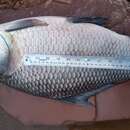Diagnostic Description
provided by Fishbase
Body deep, with depth 2.5 to 3 times in standard length (Ref. 4832). Has a large, upturned mouth (Ref. 3264), with a prominent protruding lower jaw (Ref. 4832). Pectoral fins long, extending to pelvic fins; scales conspicuously large (Ref. 4832).
Diseases and Parasites
provided by Fishbase
White spot Disease. Parasitic infestations (protozoa, worms, etc.)
Diseases and Parasites
provided by Fishbase
Fish louse Infestation 1. Parasitic infestations (protozoa, worms, etc.)
Diseases and Parasites
provided by Fishbase
Dactylogyrus Gill Flukes Disease. Parasitic infestations (protozoa, worms, etc.)
Diseases and Parasites
provided by Fishbase
Sporozoa-infection (Myxobolus sp.). Parasitic infestations (protozoa, worms, etc.)
Diseases and Parasites
provided by Fishbase
Trichodinosis. Parasitic infestations (protozoa, worms, etc.)
Diseases and Parasites
provided by Fishbase
Acanthogyrus Infestation 5. Parasitic infestations (protozoa, worms, etc.)
Diseases and Parasites
provided by Fishbase
Neascus Disease. Parasitic infestations (protozoa, worms, etc.)
Migration
provided by Fishbase
Potamodromous. Migrating within streams, migratory in rivers, e.g. Saliminus, Moxostoma, Labeo. Migrations should be cyclical and predictable and cover more than 100 km.
Morphology
provided by Fishbase
Dorsal soft rays (total): 17; Analspines: 0; Analsoft rays: 7 - 8
Trophic Strategy
provided by Fishbase
Occurs in rivers, lakes and culture ponds (Ref. 41236). Distribution limited to maximum altitude of 500 m and minimum temperature of 14°C. Surface and mid-water feeders, mainly omnivorous with juveniles feeding on aquatic and terrestrial insects, detritus and phytoplankton. Breeds in rivers (Ref. 4832). Spawners migrate during the monsoon season towards the littoral zones of flood plains (see Ref. 555).
Biology
provided by Fishbase
Adults occur in rivers, lakes and culture ponds (Ref. 41236). Mature individuals breed in rivers (Ref. 4832). Surface and mid-water feeders, mainly omnivorous with juveniles feeding on aquatic and terrestrial insects, detritus and phytoplankton.
Importance
provided by Fishbase
fisheries: highly commercial; aquaculture: commercial; gamefish: yes

